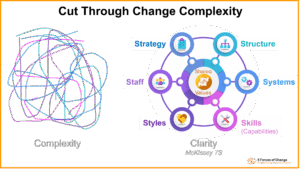My recent guest blog on the OU website is below as well as at:
http://www.open.ac.uk/business-school/business-perspectives/your-change-going-fail
Is your change going to fail?
When you look back on your change 6 months after its gone live, will you be glowing with pride or wondering where it all went wrong?
Don’t wait to find out – do something now!
When it comes to organisational change there’s often a lot of pain, but not much gain. At the heart of the matter is the effect change has on people – the very things that drive them to excel at work are deeply threatened. No wonder people oppose or avoid change. No wonder it so often fails.
Organisation have to change, people don’t. And if people don’t change there is no change!
The good news is that by understanding what makes people tick you can reverse the situation. By working with the grain of human nature you can channel people’s energy and ingenuity in pursuing change rather than in opposing it – leaving looking back on your efforts with pride not regret.
So how well are you doing right now?
You can gauge your chances of success by scoring your initiative against the forces that determine whether or not your people will change (The 5 Forces of Change). For each of the following five statements, score 1 if you ‘Strongly Disagree’ and 5 if you ‘Strongly Agree’ with the statement. Score 2, 3 or 4 if you think you are somewhere in between:
- Leaders are increasing people’s sense of Certainty throughout the change, i.e. they are communicating openly and often, and are displaying confidence and commitment to the change in words and deeds.
- There is a clear and compelling sense of Purpose for the change, i.e. the vision for the change is clear, concise and motivating and known to all those affected by the change. Plus it’s clearly aligned with the long term vision and values of your organisation.
- People affected by change feel in Control of their destiny, i.e. people have been consulted and / or involved in defining the change and / or in deciding how it should be implemented in their part of the organisation. They feel like part of the team rather than victims of the change.
- People are being helped to let go of Connections – things that must be consigned to the past for the change to succeed, such as old ways of working, old habits, old relationships and symbols of the past.
- Success is being nurtured during change, i.e. effective training is in place with coaching and support to help people through the early ‘teething period’ and up the learning curve. It is ok to ‘fail’ while trying out new ways of working, but unacceptable not to try.
Add your scores together. If you scored:
<12: It doesn’t look good – the chances are you’re heading for disaster – your people are keeping their heads down and hoping it will never happen, if they’re not already openly opposing it.
12 – 15: There is strong cause for concern. People will struggle to adapt, and when they hit difficulties, they are liable to abandon changes and revert to old ways.
16 – 19: You’re doing ok – with more focus on your areas of weakness you can still pull it off.
>19: Well done – you have an excellent chance of success. Unless the change itself is fundamentally flawed! However, with such and engaged workforce they’ll have pointed this out already and come up with a better solution.






